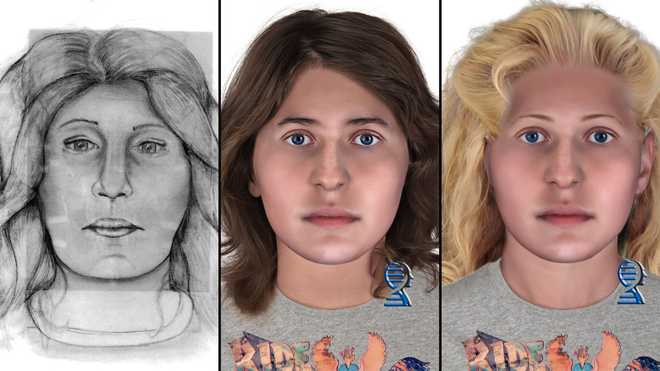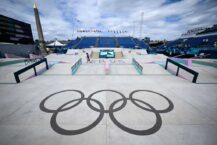No products in the cart.

This unknown woman was a victim of the ‘Happy Face Killer.’ Authorities need help in identifying her
In the early 1990s, long-haul trucker Keith Hunter Jesperson killed at least eight women in his travels across the United States. To gain notoriety, he sent anonymous confession letters to journalists and investigators, many of them signed with smiley faces.Related video above: Expert says the method used to solve a 35-year-old cold case could ‘do away with serial killers’Since Jesperson’s arrest in 1995, investigators in at least six states have worked to unravel the identities of his victims.On Monday, authorities in Riverside County, California, unveiled a sketch of what they described as the final unidentified victim in his killing spree, which also spanned Nebraska, Wyoming, Oregon, Washington and Florida.Jesperson, 68, confessed to killing the women and is serving four life sentences at the Oregon State Penitentiary. Because some of his victims were drifters or sex workers who were not in regular contact with their families, investigators have had difficulty identifying them.The body of the California woman, whom Jesperson referred to as Claudia, was found on Aug. 30, 1992, along Highway 95 near Blythe. But Claudia may not be her real name, and her identity – and that of her family – remain unknown, Riverside County District Attorney Mike Hestrin said this week.The goal, he said, is to identify her and provide closure to her family.”We hope to give this victim back her identity,” Hestrin said in a video statement. “We are hopeful someone hearing any of these details may remember anything that could help us reunite this woman with the family.”The killer described meeting the woman at a truck stopAn Oregon journalist dubbed Jesperson the “Happy Face Killer” for his rambling letters that included gory confessions and smiley face signatures.Some of his victims remained unidentified for decades, but in recent years advances in forensic genetic genealogy have helped investigators learn their names by using their DNA to connect them to living relatives.In April 2022, authorities used genetic genealogy to finally identify Patricia Skiple, 45, whose body was found in 1993 near Gilroy, California.And in October, Florida authorities identified a woman he killed in 1994 and left by the side of a highway as 34-year-old Suzanne Kjellenberg.In a renewed effort to find out Claudia’s identity, investigators interviewed Jesperson at the penitentiary late last year. He told them he met the woman in August 1992 after she approached him for a ride at a brake-check area in Victorville, California. She wanted to go to Los Angeles, but he told her he was headed to Arizona, he said.She decided to hitch a ride with him, and the two later stopped to eat at a rest stop in Indio, Jesperson told investigators. He said the pair argued about money after the meal, which led to his decision to kill her.After he killed her, Jesperson told investigators he taped her to the bed of his truck to “keep her from bouncing onto the floor … because the road was rough and everything on the bed ends up on the floor sooner or later anyway.” He said he then drove to Blythe and waited until it was dark to dispose of her body in the brush before heading to his destination in Phoenix to deliver a load.Her body was found off a highway about seven miles north of Blythe, a small desert city near the Arizona border.After his arrest in another murder case, Jesperson wrote letters to a newspaper in Portland, Oregon, and to Riverside County Sheriff’s Office deputies, confessing to killing seven other women.”I would like to tell my story!” the letter began. “I always have wanted to be noticed … so I started something I don’t know how to stop,” it continued, followed by description of the attacks.Related video below: Serial killers are ‘very complicated psychologically, to investigate,’ experts sayInvestigators used DNA technology to create a sketch of the victimInvestigators said advances in DNA technology, combined with Claudia’s remains and the killer’s description, helped them draft a sketch of the woman.Jesperson described her as being 20 to 30 years of age with blonde hair and a tattoo of two small dots on her right thumb. She had ties to Las Vegas and southern Nevada, and appeared familiar with Los Angeles and surrounding areas, he told investigators.She was wearing a gray T-shirt with a photo of a motorcycle on it when her body was found.Genealogists later determined that her biological father lived in southeast Texas but is no longer alive.”Thanks to advances in DNA technology, we are now the closest we have even been to learning who this woman was, and reuniting her with her family,” Hestrin said in a statement.Jesperson pleaded guilty to the Riverside County murder on Jan. 8, 2010. Now, almost exactly 14 days later, investigators hope the public will help them put a name to the woman’s face.They’re urging anyone who may recognize her to contact their Cold Case Hotline at (951) 955-5567 or email them at coldcaseunit@rivcoda.org.
In the early 1990s, long-haul trucker Keith Hunter Jesperson killed at least eight women in his travels across the United States. To gain notoriety, he sent anonymous confession letters to journalists and investigators, many of them signed with smiley faces.
Related video above: Expert says the method used to solve a 35-year-old cold case could ‘do away with serial killers’
Advertisement
Since Jesperson’s arrest in 1995, investigators in at least six states have worked to unravel the identities of his victims.
On Monday, authorities in Riverside County, California, unveiled a sketch of what they described as the final unidentified victim in his killing spree, which also spanned Nebraska, Wyoming, Oregon, Washington and Florida.
Jesperson, 68, confessed to killing the women and is serving four life sentences at the Oregon State Penitentiary. Because some of his victims were drifters or sex workers who were not in regular contact with their families, investigators have had difficulty identifying them.
The body of the California woman, whom Jesperson referred to as Claudia, was found on Aug. 30, 1992, along Highway 95 near Blythe. But Claudia may not be her real name, and her identity – and that of her family – remain unknown, Riverside County District Attorney Mike Hestrin said this week.
The goal, he said, is to identify her and provide closure to her family.
“We hope to give this victim back her identity,” Hestrin said in a video statement. “We are hopeful someone hearing any of these details may remember anything that could help us reunite this woman with the family.”
The killer described meeting the woman at a truck stop
An Oregon journalist dubbed Jesperson the “Happy Face Killer” for his rambling letters that included gory confessions and smiley face signatures.
Some of his victims remained unidentified for decades, but in recent years advances in forensic genetic genealogy have helped investigators learn their names by using their DNA to connect them to living relatives.
In April 2022, authorities used genetic genealogy to finally identify Patricia Skiple, 45, whose body was found in 1993 near Gilroy, California.
And in October, Florida authorities identified a woman he killed in 1994 and left by the side of a highway as 34-year-old Suzanne Kjellenberg.
In a renewed effort to find out Claudia’s identity, investigators interviewed Jesperson at the penitentiary late last year. He told them he met the woman in August 1992 after she approached him for a ride at a brake-check area in Victorville, California. She wanted to go to Los Angeles, but he told her he was headed to Arizona, he said.
She decided to hitch a ride with him, and the two later stopped to eat at a rest stop in Indio, Jesperson told investigators. He said the pair argued about money after the meal, which led to his decision to kill her.
After he killed her, Jesperson told investigators he taped her to the bed of his truck to “keep her from bouncing onto the floor … because the road was rough and everything on the bed ends up on the floor sooner or later anyway.” He said he then drove to Blythe and waited until it was dark to dispose of her body in the brush before heading to his destination in Phoenix to deliver a load.
Her body was found off a highway about seven miles north of Blythe, a small desert city near the Arizona border.
After his arrest in another murder case, Jesperson wrote letters to a newspaper in Portland, Oregon, and to Riverside County Sheriff’s Office deputies, confessing to killing seven other women.
“I would like to tell my story!” the letter began. “I always have wanted to be noticed … so I started something I don’t know how to stop,” it continued, followed by description of the attacks.
Related video below: Serial killers are ‘very complicated psychologically, to investigate,’ experts say
Investigators used DNA technology to create a sketch of the victim
Investigators said advances in DNA technology, combined with Claudia’s remains and the killer’s description, helped them draft a sketch of the woman.
Jesperson described her as being 20 to 30 years of age with blonde hair and a tattoo of two small dots on her right thumb. She had ties to Las Vegas and southern Nevada, and appeared familiar with Los Angeles and surrounding areas, he told investigators.
She was wearing a gray T-shirt with a photo of a motorcycle on it when her body was found.
Genealogists later determined that her biological father lived in southeast Texas but is no longer alive.
“Thanks to advances in DNA technology, we are now the closest we have even been to learning who this woman was, and reuniting her with her family,” Hestrin said in a statement.
Jesperson pleaded guilty to the Riverside County murder on Jan. 8, 2010. Now, almost exactly 14 days later, investigators hope the public will help them put a name to the woman’s face.
They’re urging anyone who may recognize her to contact their Cold Case Hotline at (951) 955-5567 or email them at coldcaseunit@rivcoda.org.





